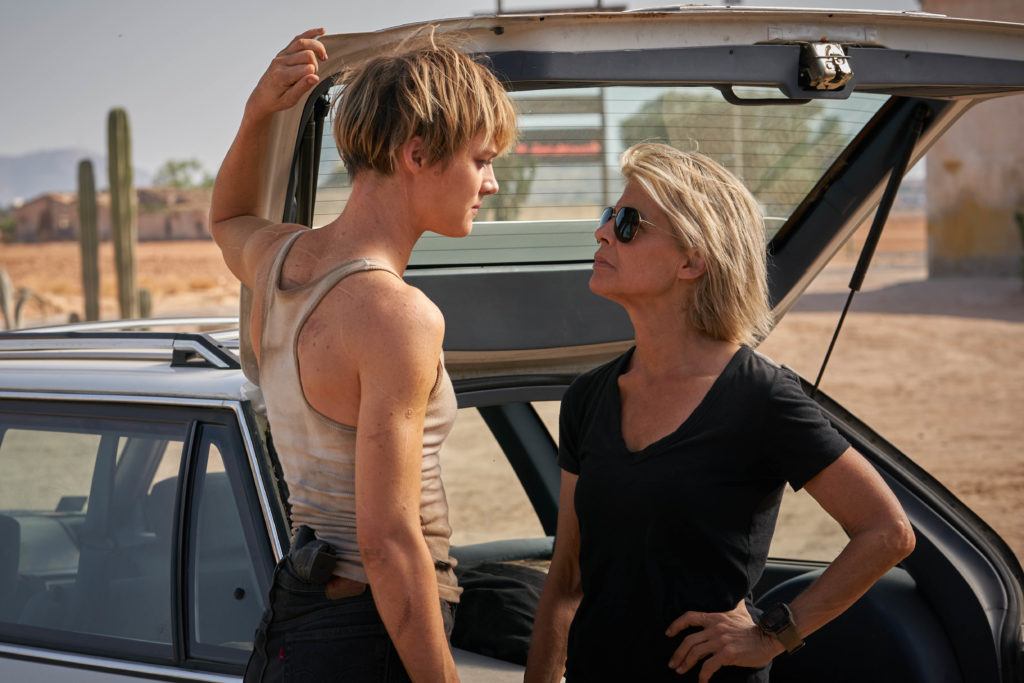Terminator: Dark Fate

Mackenzie Davis, left, and Linda Hamilton star in Skydance Productions and Paramount Pictures' "TERMINATOR: DARK FATE."
By the middle act of James Cameron’s TERMINATOR 2, his protagonist Sarah Connor (Linda Hamilton), mother of John—the future savior of humanity—walks, talks, thinks, and even dresses, like a soulless machine. A one-woman army, she stalks and attempts to assassinate Miles Dyson (Joe Morton)—unwitting creator of SkyNet, an artificial intelligence network. This harbinger of mankind’s destruction becomes self-aware the morning of August 29, 1997. Lucky for me, my 23rd birthday passed without incident.
In this perpetual franchise, now in its sixth iteration onscreen (excluding the short-lived television series, THE SARAH CONNOR CHRONICLES), one begins to wonder why we need another J.C. when Mary’s quite capable of doing all the heavy lifting herself. In the 80’s and 90’s, James Cameron and timid studio heads—likely wrapped up in their own egos—avoided such questions of Biblical import. You can’t tell me James Cameron never noticed his own initials. Thirty-five years later, here we are.
In Mexico City, Dani Ramos (Natalia Reyes) and her brother, Diego (Diego Boneta), assemble automotive components at a factory employing roughly three thousand workers. Instinctive and gregarious, Dani cares for her brother who manages along, in spite of himself, until robotic automation threatens to replace him. When she confronts the manager, he explains, “Diego isn’t you,” foreshadowing skills Dani doesn’t yet know she possesses.
There and then, a woman and man from the future appear in different “time vortexes” identical to the portals through which previous Terminators traveled to the present. Given this formula’s recurrent use—thing hunts person, protector hunts thing, person destroys thing, person lives, protector dies, world saved—the trailers already establish Grace (Mackenzie Davis) as the bodyguard.
Directed by Tim Miller and written by David S. Goyer, TERMINATOR: DARK FATE feels less like a sequel or a reboot than a do-over. By the end of Cameron’s original film, inspired by the provocative works of Harlan Ellison, an interesting question emerges: How does experience change a person? TERMINATOR 2 dips its toes in this question, but never dives in.
Though beloved at the time, T2 hasn’t aged well. Its tone and style—its marketing, merchandising, and endless pop culture inserts, including the soundtrack tie in with Guns’N’Roses—feels more and more dated. A metaphor for the intervening years between Jesus’ birth and crucifixion, the film entertains yet doesn’t convince us of John Connor’s (Edward Furlong) value beyond a plot device—an open target for someone else to save. Sarah and Good Arnold save the world, or at least one version of it.
Speaking of worlds: As if to justify a perpetual franchise like Star Wars or the Marvel universes, we learn there are many possible futures from which good guys and bad guys can return to the past. Sarah Connor, guided by forces unseen, lies waiting for them. In this case, the Rev 9 (Gabriel Luna) Terminator—carbon black skeleton, tentacles, skinny and vaguely-Hispanic appearance; clearly a villain—commandeers the resources of our surveillance state (watch for the multiple foil-wrapped cell phone jokes). It infiltrates a datacenter run by a company named for Arius—a third-century, Alexandrian priest whose teachings emphasized the subordination of the Son to the Father in the Christian Trinity. The relationships between the trio of women galvanize into a Trinity of their own agency: past, present, and future, likewise uniting the qualities of each—Sarah’s trained discipline, Dani’s fearlessness, and Grace’s inner strength.
At times inelegant in its execution—drones and immigration detention centers, superfluous dehumanization in a movie about cyborgs—yet certainly more curious about its own implications, DARK FATE is on some levels a better film than T2. We learn, for example, what happens to Terminators if they live long enough and get bored. Let’s just say, aside from developing greater curiosity about purpose beyond war, their pattern recognition skills come into play. Some things never change: Sarah loves her rickety pickups and station wagons for getaways. Why don’t they ever take a cue from Arnold’s John Matrix in COMMANDO and steal a Porsche? But never mind, there’s more than one way to get the job done.
In particular, Mackenzie Davis, the breakout star of AMC’s television series, HALT AND CATCH FIRE, shines as Grace. Augmented by cybernetic and metabolic enhancements—half a pharmacy’s worth of drug cocktails—she can predict the trajectory of a bullet before it’s fired, and her fly-swatting technique puts Mr. Miyagi’s to shame. But something doesn’t add up. We know the Dark Terminator’s advantage—nanotech that doesn’t require his earlier predecessor’s brute strength—but his only motivation is his mission. A uniquely human force drives Grace with the purpose and intensity of ten Terminators.
Whenever an exhausted franchise brings back a veteran actor, we anticipate a fateful send-off to give the new blood their space. Late in the film, Linda Hamilton, looking war-weary and haggard, has the wind taken out of her—not by a brawl with a Terminator but by the realization that everything in which she’d invested her hopes is gone. While heavy-handed in other places, Goyer’s deconstruction of abortion and/or miscarriage, and the myths spread about them by pro-life literature (read: propaganda), sneaks into this moment. Overcome with grief, Sarah realizes the loss of one child isn’t the end of the world.